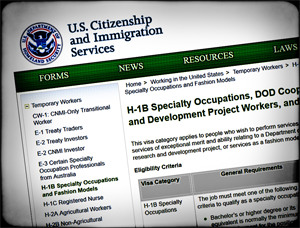This article was last updated on April 16, 2022
Canada: ![]() Oye! Times readers Get FREE $30 to spend on Amazon, Walmart…
Oye! Times readers Get FREE $30 to spend on Amazon, Walmart…
USA: ![]() Oye! Times readers Get FREE $30 to spend on Amazon, Walmart…
Oye! Times readers Get FREE $30 to spend on Amazon, Walmart…

If six major league baseball players all committed errors on single play, you can be sure that the sports pages would notice.
But a similar feat of mass incompetence in the field of H-1B visas — for professional workers with at least a bachelor’s degree — has been missed by everyone involved until now.
The guilty (or at least sleepy) sextet includes two government regulators, a diplomat, an airport inspector, an administrative judge (probably), and certainly a reporter for the otherwise competent Law360 news service. I know the names of two of the slackers, but since I do not know the names of the other four, all will remain anonymous.
In some senses, this is an all too routine story of how a greedy employer used one of the nation’s numerous immigrant worker programs to deeply underpay his alien worker, and kept doing so for years until someone woke up and obtained $130,000 in back wages for the exploited alien.
But what is not routine is the basis for all this grief: A set of government agencies agreed to let what appears to be one small pizza restaurant use the H-1B program to hire a pizza cook.
Now there are suggestions in Congress that a minimum wage of $100,000 be set in the H-1B program, and the program is lauded by big tech companies as a way of bringing “the best and the brightest” to our shores.
But is it also used to hire low-skill pizza cooks? Not routinely, but it was in the case at hand, Administrator, Wage and Hour Division v. SRV Pizza Inc.
The first name of the culinary worker involved — and I am not making this up — is Subhash.
The rest of his name is Tehlan. Sunil Singh is the employer. Singh and Tehlan are both Indian names.
When I run into cases like this, I employ a simple test. What can I, as a not-particularly-skilled-computer-user, learn in five minutes at the screen? First, I found in this instance that the government records were scant, locating only a two-page approval of the settlement by the administrative law judge.
Then I went to Google and looked up the pizza shop. And found this on a service called Buzzfile:
SRV Pizza is located in West Chester, PA. … this organization has been operating for approximately ten years. SRV Pizza is estimated to generate $114,701 in annual revenues and employs approximately 6 people at this single location.
The Law360 news story identified the employer as a “Pennsylvania pizza restaurant” so I suspect I found the right one.
If any of the people handling the case had done what I had done, they might have had second thoughts about granting an H-1B visa to such a tiny, low-tech outfit. The mere mix of the H-1B program and the name of the employer should have raised eyebrows, but it apparently did not.
Who are the sleepy or careless six in this case?
First, there was someone at the U.S. Department of Labor who granted the Labor Conditions Application (LCA) that set the process in motion.
Second, there was someone at U.S. Citizenship and Immigration Services who rubber-stamped the next stage of the process.
Third, and this puzzles me because there should have been a face-to-face conversation between Subhash and a U.S. visa officer, the latter should have known enough about the H-1B program to notice that this was an unusual, to say the least, application. If Subhash had been in the United States when the application was being examined, he would have had to go to the Department of Homeland Security for an adjustment of status instead of seeing the diplomat.
Fourth, assuming that he flew in from India, Subhash would have presented his H-1B visa to the inspector at the airport, who might have asked (but probably did not): How did you get such a visa to work in a pizza shop?
Fifth is the administrative law judge. I do not fault him for his ruling, and perhaps he called this odd decision to grant an LCA to the attention of someone else at the Department of Labor, but that is not shown in any available court record. He may have simply operated in one of those proverbial silos and not gone beyond the immediate issue before him.
And then there is the reporter who wrote the story straight from the decision, without, apparently, thinking about how it came to pass in the first place.
One does not need any arduous system of “extreme vetting” to sort out such cases, just a tiny bit of curiosity on the part of just one of the feds involved. That’s all.
Click HERE to view more.
You can publish this article on your website as long as you provide a link back to this page.

Be the first to comment